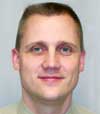
Clinical Assistant Professor
Stony Brook University
Stony Brook, NY
AARC Member since 1995
AARC Activities
2007—current Sleep Section Resources Directory Committee Member
Affiliate Activities
New York State Society of Respiratory Care, South Eastern Chapter 2006—2010 Board Member
Sleep Review Magazine, Editorial Board, 2004—present
2008 NBRC item writer for the SDS examination
Related Activities
Conducted numerous AARC-approved CEU courses related to sleep technology, 2001—present
Acted as a liaison between Stony Brook University School of Health Technology and Management Respiratory Care Program and CareFusion in the annual donation of the Sleep Scholarship; in 2010, obtained a $3,000 scholarship to be awarded to two students in the optional polysomnography tract of the respiratory care program
Site visitor for CoARC, specializing in polysomnographic accreditation for respiratory care programs. Have been site visiting since November 2005—present.
Assisted with the design, plans, and requirements of the two-bed sleep training facility at Stony Brook School of Health Technology and Management Respiratory Care Program and the Polysomnographic Technology Certificate Program
Education
BS, Stony Brook University 6/1997
RRT 6/1998
RPSGT 12/2000
SDS 6/2010
Publications
Rozensky, R., (2006). What it takes to be the boss. Learn Sleep Center Managers’ Secret to Success, Advance for Managers of Respiratory Care, November 2006
Rozensky, R., Smalling, T., (2006). One Size Does Not Fit All: Challenges to Polysomnographic Testing; the Severely Obese Patient, RT-The Journal for Respiratory Care Practitioners, October 2006, pp. 22-24
Rozensky, R., (2006). Diagnosing the Diagnoses, Sleep Review, July 2006.
Rozensky, R., B. White, (2006). Accreditation Issues in Polysomnography, AARC Times, March 2006
What AARC or Chartered Affiliate offices/positions have you held where you feel you made a significant contribution to our profession? What is the contribution and how will you apply it to your new position if elected?
Since graduating Stony Brook in 1997 and entering the field of sleep disorders, I have kept pushing further and further to promote sleep education to the clinician and to the general public. After passing the BRPT in 2000, I began working as an adjunct with Stony Brook, offering weekend courses in sleep technology. I also became a clinical preceptor for Stony Brook and offered to have students rotating through the Mather’s Sleep Center. With Dr. Smalling’s and Stony Brook’s support, they opened up one of the first CoARC PSO programs in the country, and I was hired as a part-time adjunct faculty member to teach the courses. Over the years, we have had over 80 RT students complete the PSO program. Since the inception of the program at Stony Brook, I pushed for the expansion of the program into a dedicated 2 bedroom-testing facililty with 12 workstations.
As a leader, what do you see as the top 3 priorities for the AARC, and what steps would you take to advance those priorities?
One of the top 3 priorities that I see for the AARC is to increase membership. Many institutions may not cover the cost of an employee’s membership. A way to entice facilities is to offer a group discount, 20 or more members from one facility get 25% off each membership, plus get 3 webinars for free for each individual.
The second issue would be addressing regional conferences. Although the annual and the summer meetings are important, it can be rather expensive and inconvenient for many people. Holding 3–4 meetings in the corners of the US away from the annual meeting would help bring in revenue and membership.
Lastly, I feel that many institutions do not foster leadership skills. Having specific classes on management where it can be limited to 30–50 members per instructor will allow more interaction. Also, marketing this to hospitals and employers to help them with the transition of staff to management will help market the AARC.
Leadership development is an issue facing many organizations, including the AARC. What can the AARC do to mentor the next generation of leaders?
To get younger people involved, it would be good to offer some CEU’s to act as a reward for participation. Each year an individual is on a board, or committee, they are allowed to view 5 webinars for free. Since the NBRC has changed their criteria to maintain the credentialing, each section that they participate on would allow them to get the 5 webinars in that section for free.